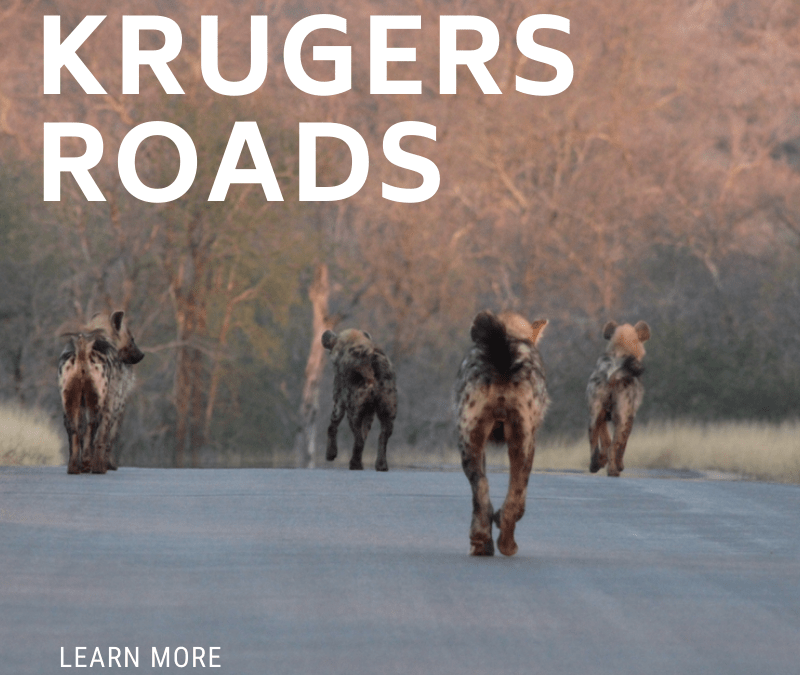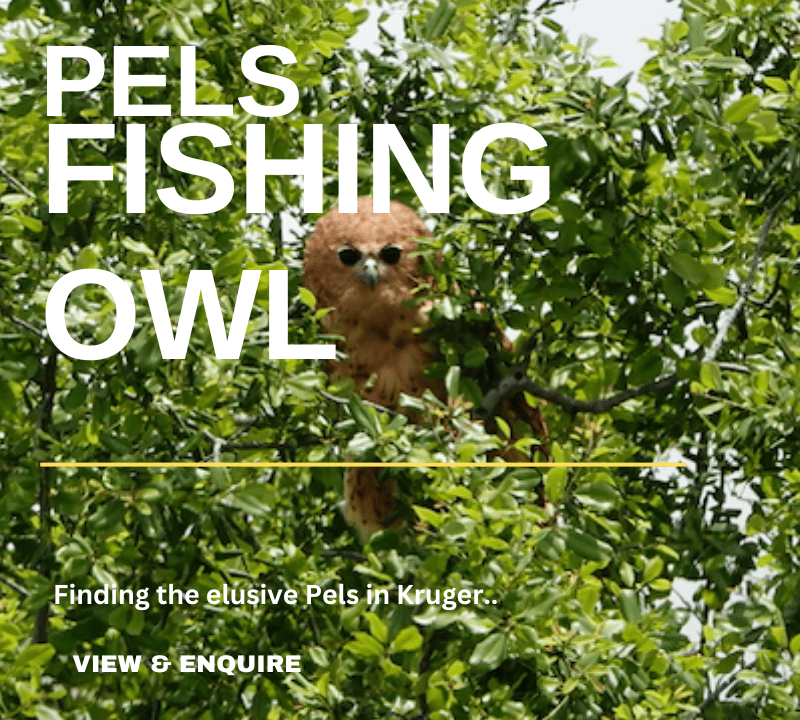
The Kruger National Parks roads
Why Krugers roads are more sustainable for wildlife and safari tourism.
The Kruger way.
A lot has been said over the years about the Kruger National Parks policy of “no off-road driving”. As passionate Kruger conservationists, our guests have often asked us why we cannot follow a species off road and into the bush. The reality is that Kruger’s policy around the protection of the natural environment is strongly weighted in exactly that, preservation, and to protect and conserve this last great wilderness at all costs. Whilst many still think that Kruger doesn’t offer enough access, there was a lot less way back when.
Today, Kruger has established a network of roads that consist of both gravel and tar which traverse the length and breadth of the Park and are well maintained. Many of these roads were already in place as simple gravel tracks or strip roads established back in the 1920’s as direct routes from ranger station to ranger station. During the late 1940’s these simple tracks where upgraded to more prominent gravel roads and in 1955 the first road was tarred. This was the main route from Numbi gate to Skukuza known as the Naphi route or H1-1.
Since the first establishment of roads in the Kruger National Park, the Park has provided guests with just over 1,700km of roads to traverse this wilderness, carefully placed in sustainable areas that also offer guests the best views of its many diverse landscapes (read Kruger’s geology and landscape for more insights).
Considered Africa’s crown model of conservation management and practice, Kruger has long been lauded for its cutting edge approach to savanna conservation with much of Africa coming to Kruger to learn and better understand their similar environments elsewhere on the continent. For this we must thank Dr R Bigalke, who hailed from the National Zoological Society in Pretoria and was appointed to the Parks board after the retirement of famous Warden James Stevenson-Hamilton. After his appointment the park gave rise to the era of science and implement a multitude of scientific programs to better understand the park and provide the much needed information to assist and intervene where needed.
The debate has always been around the best way to handle conservation areas and how to best allow nature to maintain itself. One of the many ways the park decided to do this was to limit intrusion and establish a network of roads rather than allowing guests to drive wherever they felt like it. It was therefore decided to utilize existing roads and add only what was necessary to connect camps.
In order to limit further destruction of the bush, the park utilized these early routes and turned them into more permanent gravel roads and then established additional routes that would capture the best scenery and landscapes offering guests the best game viewing based on the locations these roads traversed. Very little has changed over the past 60 years with exception of the S1 road from Phabeni Gate that was tarred in the early 2000’s. The park began adding adventure routes around certain camps which essentially were roads that made up the 4,500km of maintenance and management roads which only Park officials can use. These roads are all gravel and cut through blocks creating short-cuts for management in the event of an emergency, for anti-poaching and general maintenance of water points etc. These roads are clearly indicated as they all have a no-entry sign at the entrance.
Its important for guests to realize that Kruger National Parks road network, as specific and prescriptive as it may seem, serves an incredibly important part in the management and maintenance of this natural environment. By reducing guest footprint the Park ensure the continuity and natural state of this vast wilderness area and ensure the preservation of it for future generations. Other Parks in East Africa such as the Serengeti and Maasia Mara suffer tremendous erosion as safari vehicles annually destroy roads and with heavy rains further prevent usage. What happens then is that Safari vehicles continue to look for alternative tracks to traverse and so destroy more and more areas unnecessarily. With only an estimated 200,000 international visitors a year the Serengeti road system is significantly impacted and lacks the funding to establish a more permanent road system such as Kruger. We can applaud Kruger’s vision as Kruger’s visitors are over 1,600mio per annum.
The truths about driving off road on Safari – Kruger vs Private ?
With Kruger’s wonderful road infrastructure in place it still does beg the question why so many travellers think that the only way to go on safari is to be able to drive off road into the bush in search of hidden treasures making Kruger’s prescriptive approach less exciting. Its true, most guests ask why they cant drive off road like the private lodges and are sometimes disappointed until better understanding why. It may seem like a negative but it really is the better and more sustainable practice and here’s why.
As a comparison we just returned form a Private Lodge in one of the most prestigious Private Reserves in the Greater Kruger National Park region. The place was incredible and offered wonderful luxury, vistas and privacy for our group and was everything you would imagine of a Luxury Private Safari Lodge. We have great sightings and of course off-roading meant that we got very close, but there was an aspect that nearly spoiled to entire experience for us…the off-roading. Why you may ask ? well, as a business we are completely focused on the experience and whilst this was in all regards your typical exclusive Private Lodge safari, the reality around how destructive the guides where being in their vehicles really hit home. Over the 4 day period our guides, as lovely as they where, never made any attempt to tread cautiously through the savanna but at every opportunity they would crash through the bush driving over everything and anything in pursuit of a feline in particular and the rest of the Big5 included. This behavior just didn’t sit well as there was no regard for protecting and conserving. We drove over trees, bushes, old logs, termite mounds. We drove through sensitive sodic areas, across long thick grasslands and drainage lines. There wasn’t a single obstacle that our guides didn’t try and conquer. This behavior was completely unnecessary and left us feeling guilty as we realized that there was nothing sustainable about our daily game drives. The destruction caused by our guides meant that when we left, we left the environment harmed, destroyed and in need of restoration. As a result of this we had to instruct our guides to please no longer off road as we just didn’t enjoy it and would rather lose out on the sighting than mess up the bush. Whilst the above is quite possibly the extreme example, it has to be said that if this isn’t carefully managed by the Lodge, reserve or concessions owners, the effect on the savanna is negative and doesn’t contribute to conservation at all.
On the other side of the coin you have the Kruger National Park experience which does limit your proximity to a sighting because you cant drive off road and as have to adhere to the Parks rules of staying on designated roads. There is also the reality that whilst at a Private Lodge you will only do 2 drives per day of 2 to 3 hours each in which you are likely to see cats up close, in Kruger you could be driving all day to find a feline. Kruger will offer you significantly more general game sightings including elephant and buffalo but finding Lion, Leopard or Cheetah will require more time and a better understanding of where to go and what to look for. This can all usually be done over a 3 Day Safari. So both have there pros and cons but when it comes to off-roading we find that Kruger’s policy is far better by way of conservation in action and preserves and guarantees pristine untouched wilderness for generations to come, the way it should be. If you are then worried about not seeing anything yourself, well give us a call, we’ll make sure you don’t miss a thing. If you want to get closer to things then that’s also easy, why not try a walking trail with us.
Here are some of our Favorite Roads in the Southern to Central region of Kruger National Park between Crocodile Bridge and Satara Camps:
H2-2 also known as Voortrekker road is a dirt road that is roughly 34km from Pretoriouskop Camp to Afsaal picnic site. This road follows the old Wagon route and offers wonderful views and vistas. This road is all about history and dates back to 1885 and the famous story of Jock of the Bushveld.
H10 is a 41km tar road from the H4-2 Lower Sabie junction that heads north to the H1-2 Skukuza / Tshokwane road. This road offers wonderfully diverse landscapes from thickets to grasslands as well as our favourite look out point – Nkumbe.
S3 Sabie river road is 24km of sand road from S1 Doispane road junction and heads east to the H11 Paul Kruger gate. This road follows the Sabie river and whilst it may be along a boundary, the river provides incredible habitat and is a particularly good birding road. The last 5 km from the S4 river link to the gate its can be really good for Lion, Leopard and up close and personal Elephants.
S21 N’watimhiri road is 27km of sand road from S114 junction at Renosterkoppies dam and heads east to H4-1 Skukuza-Lower Sabie road. This road is all about wilderness and the raw feeling of being somewhere remote in Kruger. Its offers goo to great sightings but the nature experience is whats special.
S35 Lindanda road is a 17km sand road from Orpen loop just north east of Tshokwane, and heads north to S37 Trichardt road. It’s a less travelled road but offers wonderful grassland viewing that is up close as the road is narrow and more intimate. This road passes the site that the first Ranger Harry Wolhuter was attacked by a Lion which he killed with his knife and using his belt fastened himself up in a tree until help came.
S37 Trichardt road is 36km sand road which runs parallel to the H1-3 on the west and the lebombo mountain range on the east. This is an incredibly beautiful road with great birding all along and good game viewing particularly towards N’wanesti picnic site.
S83 Marula loop is a 7km sand road that loops along the western side of the north H1-2 which connects Skukuza Camp to Tshokwane Picnic spot.
S100 N’wanetsi River Road is almost halo’d ground in Kruger and for good reason. This road offers 21km of arguably the best dirt to find Lion in Kruger. The road skirts along the northern bank of the N’wanetsi River all the way to the S41 junction. The road offers sweet grazing grassland along with dense riparian water frontage that has pools of water all year round. The combination of these make for great game viewing.
S118 Mlambane River Road which is 8km of Sand road from H3 Malelane-Skukuza Road east to S114 and Ampie-se-boorgat water hole. We suggest connecting to the S119 and following the entire water course.
S119 Continuation of the Mlambane River Road. It’s a additional 6km of Sand road from S114 junction and takes you Gardenia hide which in the summer months when the pan has water can be great from all of the Big 5. This connects back to the S25 junction.
S126 Sweni Road is another favorite road that offers 22km of sand road along the Sweni River system heading west and running parallel to the river on the northern side. The riverine habitat is great for Giraffe, Elephant and Leopard with many smaller browsers found in the shadows. With 3 water points as well, namely Sweni, Mahungumula and Welverdiend, in the dryer months this road can be wonderfully productive.
S83 Marula loop is a 7km sand road that loops along the western side of the north H1-2 which connects Skukuza Camp to Tshokwane Picnic spot.





